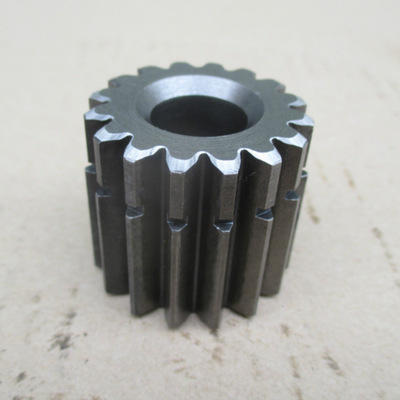Working principle of gear pump brake valve
(1) valve operation
When the control lever is neutral, the oil pressure at port P is equal to that at port R. When the oil pressure of port P increases, the pressure area of plunger, the pressure of port P, the elasticity of tension spring and the pressure of chamber G are balanced, so the valve starts to operate.
When the piston moves, the pressure of chamber g changes, so the safety pressure is affected by the tension spring and piston.
Because the piston moves, the safety pressure increases from P1 to P, and the pressure (P2) and tension spring force change accordingly.
(2) valve pressure increase operation
When the pressure of port P increases, oil pressure is generated in chamber g, which makes the force of tension spring balance with pressure (PA), and then piston 21 moves to the left.
The valve operates (releases) under P1 safety pressure and the piston moves to the left. Piston 21 forces oil flow through the orifice to port R. When the piston reaches the top of the stroke, the pressure in chamber G is greater than that of the tension spring, so the piston moves to the right. The piston begins to move, and the chamber h and piston 7 dump on the sliding surface through the groove. The valve pressure set in chamber g slowly rises from P2 to P.
When piston 7 reaches the regulating socket, the oil pressure of chamber g reaches the safety set pressure.

(3) valve pressure drop operation
When the oil pressure of port P becomes 0, the oil pressure of chamber g rises to the pressure of oil tank. The plunger 9 moves to the right, the piston 7 is pushed to the left by the tension spring 16, and the piston is pushed to the right by the tension spring 1. When the check valve is opened, oil is pumped from port R, and piston 21 returns to the original port.
3. Function of preventing cavitation
When the rotary motor is rolling, if the control valve is in the neutral state, the weight of the upper structure will make the device rotate continuously, and the pressure on port B will continue to increase. At this time, the valve at port B should be opened to avoid the influence of high pressure on the circuit. In this way, a hole phenomenon will be produced. Therefore, oil should be supplied immediately after the control valve is closed. Turn over the make-up plunger, the oil flows through the return oil circuit to make up for the oil supply, so as to prevent cavitation.
Source: Excavator gear accessories http://www.hx-machinery.cn/
-
12-17
Working principle of gear pump brake valve
(1) when the valve control lever is neutral, the oil pressure at port P is equal to that at port R. When the oil pressure of port P increases, the pressure area of plunger, the pressure of port P, the elasticity of tension spring and the pressure of chamber G are balanced, so the valve starts to operate. When the piston moves, the pressure of chamber g changes, so the safety pressure is affected by the tension spring and piston. Because the piston moves, the safety pressure increases from P1 to
-
12-17
Methods of waterproof scale for gear fittings of excavator
We should all have seen excavators, so do you know how to prevent the scale of excavator accessories? Today, we specially invited modern excavator accessories manufacturers to tell us the methods of modern excavator accessories anti scaling. Let's follow Xiaobian to have a look! (1) magnetize the water quality. Some small magnets are placed in the engine structure system. The magnetic field generated by these magnets magnetizes the cooling water. The magnetized water can reduce the scale composi
-
12-17
How to maintain gear parts of Jiangmen excavator?
The rotary table of excavator accessories plays an important role in the daily work, because the bad working environment or improper operation of the excavator will cause a series of failures of the rotary table, such as wear aggravation, abnormal noise, oil seal replacement and so on. When encountering these problems, first of all, open the cover plate around the boom mounting base, and investigate the amount of grease in the big gear ring and the wear condition of the gear ring. Because of the
-
12-17
How to change gear oil for rotary motor reducer?
Oil change time: after the oil change cycle is reached, the new gear oil must be replaced. After the excavator stops working for half an hour, the gear oil is at the bottom of the reducer, and the oil temperature is not too high or too low. The old oil can be drained as much as possible. After the old oil is drained, tighten the oil drain screw, and then add new gear oil from the gear oil filling port. Pay attention to the adjustment at this moment Check the travel scale to avoid too little or t